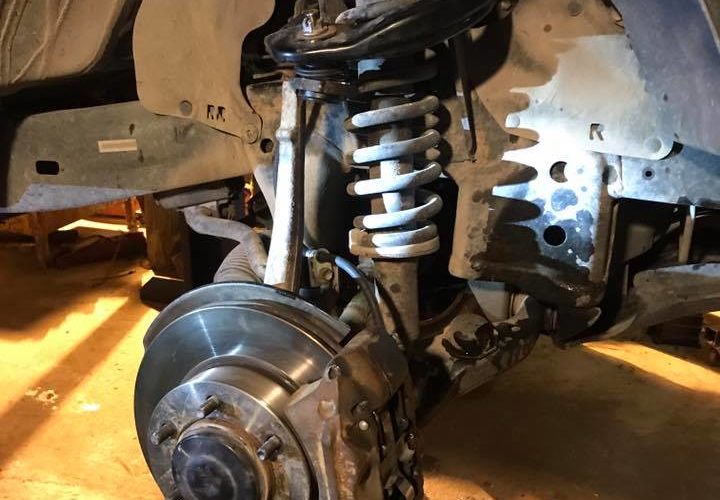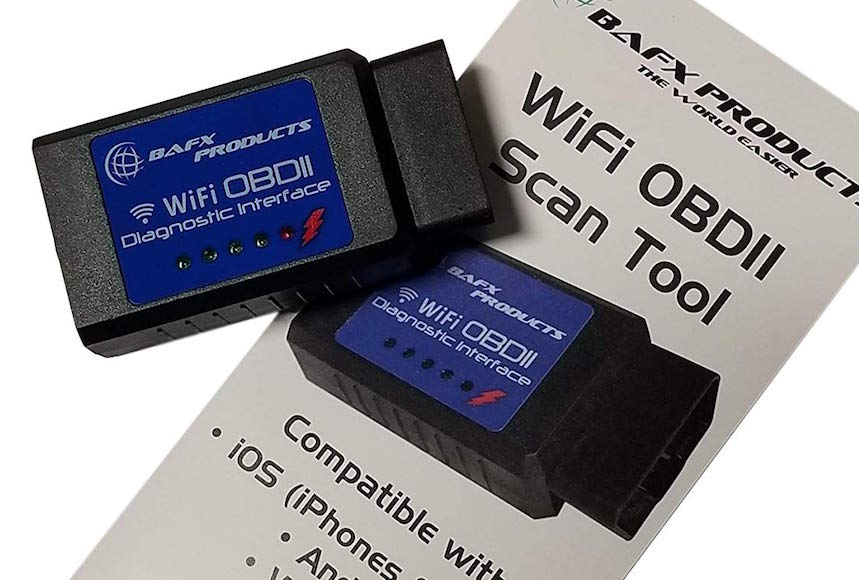Table of Contents
Conclusions First:
- Lower Control Arm (LCA) bushings on Toyota Tacomas from 1995-2005 are known to go bad– they cause steering problems, shifting while braking, and wandering steering.
- The best test I have found for LCA Bushings is the “Steering Wheel Test” outlined below.
- After replacing Lower Control Arms you should get an alignment ASAP.
- Steering rack bushings are also known to go bad (rack and pinion bushings). Watch your power steering rack for shifting movement while doing the “Steering Wheel Test,” if a lot of movement is noticed replaced your bushings with the Energy Suspension Kit.
This is specifically for Toyota Tacoma’s from 1995 to 2005 pre-runners and 4×4 trucks (2.4 and 3.4l). The issue with diagnosing these trucks is that it can be hard to get the truck to act up when it isn’t loaded (on the ground) or driving down the road.
Why is diagnosing suspension components difficult on these trucks? Well, if you could work on it while it was driving down the road and see what was shifting or lose it wouldn’t be so hard. But when you are under it in your driveway all the sudden nothing is loose and you don’t feel any play in the wheels. But you know something has to be loose, because when you step on the brake the whole truck shifts and pulls one way or another.
How To: Find Wandering Or Loose Steering Toyota Tacoma 95-2005 Trick:
Here is the trick I used recently when working on my friends 2001 Toyota Tacoma 2wd. It saved me tons of time and fixing parts that weren’t actually bad.
Steering Wheel Test Steps:
- Remove any shielding or underbody skid plates that block your view of the components. You want to be able to see the rack and pinion, LCA’s, and tie rod ends.
- One person gets under the truck with a flashlight, and the helper gets into the driver seat and takes ahold of the wheel.
- SET E-Brake and make sure the person is in Park when doing this (or block the rear wheels on a manual).
- The person in the car moves the steering wheel sharply left and right in short side to side movements. It is a jerking motion meant to show any play in the steering components. Do this at full stop left, right, and in the middle.
- Watch all the components for play (LCA, rack, and pinion, tie rod ends, etc). You can even rest your hand on a tire and feel if there is any play and then look for it.
- The most common spots on Tacoma’s you are going to see play are the lower control arm bushings, tie rod ends, and the rack and pinion bushings.
Shops Get it Wrong Sometimes:
I had taken it to a shop for her and asked them to do a full check of the suspension components (I don’t have access to a lift right now) and this shop only charges $20 for suspension checks.
I was under the truck with the technician and the wheel had a ton of play due to a ball joint nut being loose. It was on hand-tight, thank god for cotter pins. We tightened it up and the play was gone in the steering wheel– but, he suggested that the play was still in the ball joint (it just needed to be loaded and driving down the road). This sounded right to me, but I was suspicious that this wasn’t really the only part that was bad.

I replaced the ball joint the next week and literally, the truck drove exactly the same– it didn’t change a thing.
How was the truck driving? The second you touched the brake pedal (even lightly) the whole truck would shift and the steering wheel would pull to one side. It felt physical, like the actual truck was shifting– not just a stuck brake caliper.
What is the best way to check your suspension on the ground at your house on a Toyota truck?
Stick with the basics, check for play at the wheel and keep a pair of pry bars around to look for play in ball joints. But, one of the best techniques for a good suspension check on these trucks is to jack the truck up enough that you can get under it (but leave the tires slightly loaded on the ground). Now have some get in the car and jerk the steering wheel left and right fast, and try it at both full right and full left. Once you hear a noise or feel a looseness, keep the wheel in the part and have the person continue to move the steering wheel. Look for the play, use your hands to feel where it is shifting, and check all the bushings (rack and pinion bushings, lower control arm bushings, ball joints, and everything down there. Some common failures on Toyota Tacomas that lead to sloppy steering or weird pulling when braking are the lower control arm bushings, ball joints, and potentially wheel bearing issues. Make sure to check everything.
Why the Steering Wheel Test Works:
It stresses the suspension components out and lets you see what is moving easily. Without this test, it can be very hard to know whether a bushing is bad or not. Bushings are made to have some play in them, hence why they are made with rubber, so it can be hard to know when to make the judgment call.
When you turn the steering wheel left and right fast while someone is under the car checking things out, it becomes very clear where your steering issue is. It helps you not shotgun parts at a car not knowing what is causing the steering problem. Trust me, when I say that people spend $1000’s of dollars on auto-repair for items that their car didn’t actually need.
Wouldn’t you rather know what was causing your steering wander, looseness, or clunking and fix it the first time?
Here is a video of the steering wheel trick that works great– plus, a video of my lower control arms on my friends 2001 Toyota Tacoma where you can see the bushing flexing.
Yes, the video isn’t great quality. Yes, he doesn’t really explain what the difference between a good bearing and a bad bearing looks like. But, this test saved me from replacing unnecessary parts on my Tacoma and you should have it in your arsenal.
Don’t just jack the car up and grab the wheel looking for play– also do this test and find those lower control arm bushing problems.
This is seriously a great suspension check trick and hopefully, you realize how useful it is.
Bad Lower Control Arm Bushing Symptoms on Toyota Trucks:
- When you first press the brake pedal the truck dips, shifts, feels unsteady and then tends to straighten out.
- Clunking or metal on metal sound when pulling out with the tire fully left or right.
- Loud noises over bumps or clunking.
- Steering Wheel Vibration
- Weird tire wears patterns (front) despite all efforts at alignments and balancing.
- Steering Wandering Feeling.
Why is diagnosing lower control arm bushings so often overlooked or missed?
Simply put, it is MUCH easier to find play in a ball joint or a tie rod end. The test is simpler, and the amount of pressure needed to see the play in the bushing/bearing is much less. Just grab the wheel and try to move it back and forth, and on some cars, you might have to pull out the pry bars to really check.
Well, with your lower control arm bushings even with pry bars it can be hard to know what is too much play and what isn’t. It can also be hard to get any sort of leverage on your pry bar if you are working on the ground under jack stands.
That is why I highly recommend the steering wheel suspension trick. Grab the wheel and shake it left and right while someone is under the car looking for play.
Pro tip: try to find that point where it is the loudest or the play in the steering feels the worst. Keep it there, and keep going left and right on the steering wheel until the person under the car finds the exact spot where the noise is coming from.
No more guessing about what part is bad, and no more wasting money throwing parts at your car. Seriously, I hadn’t heard of this trick until I used it on my Toyota Tacoma and it was a lifesaver.
You can also test those pesky racks and pinion bushings that go bad on Tacoma’s using the same test (actually it is the easiest way). It is important to remember that the play in your steering could be coming from multiple bad parts as well (however, if the play is really bad– typically it is from one “shot” part).
Other Suspension Parts on Your Tacoma To Check:
Rack and Pinion Bushings— they make a “set” where you can easily replace the bushings while the rack and pinion stays on the truck.
For wheel shaking while driving at freeway speeds– make sure there is NO dried mud on the inside your rims.
Bent rims (wheel shaking at higher speeds 60-80mph).
How To Check Wheel Bearing & Tie Rod Ends:
Lower Ball Joint Specific Test:
Lower Control Arm Bushing Replacement Video:
Conclusions:
Lower control arm bushings are often overlooked on Toyota Tacoma trucks for causing wandering and loose steering. They can make your truck feel downright SKETCHY to drive. I hated having to brake while driving my Tacoma because it would do such a nasty pull and weird dropping feeling.
After replacing the lower control arm (I replaced the whole unit for $140, instead of the bushings) the bad steering has completely gone away.
Some tools that are very helpful for this job (links to my favorites on Amazon):
1/2″ Milwaukee High Torque Impact Gun (Removing castle nuts on ball joint, tie rod ends, and lug nuts– makes quick work).
1/2″ Metric Impact Socket Set Shallow
1/2″ Metric Impact Socket Set Deep
1/2″ Torque Wrench up to 250ft-lbs
3/8″ drive ratchets and sockets
Ball Peen Hammer (for removing the tie rod ends and the lower ball joint)
Factory Service Manual for Your Year Tacoma (for torque specifications and repair guidelines)






